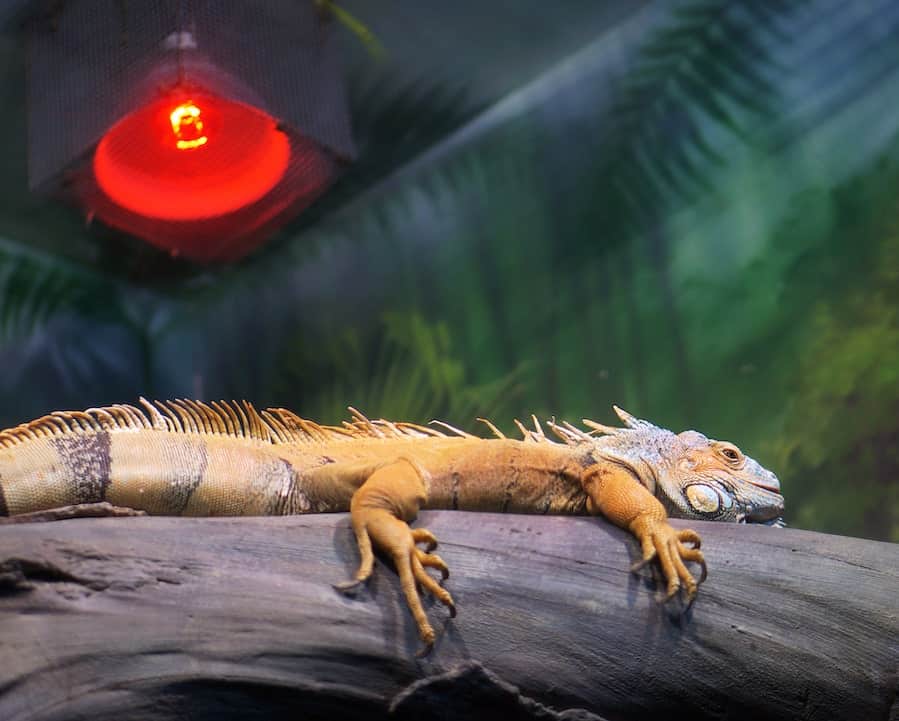Iguanas are ectotherms (cold blooded), which means they can’t produce their own heat. They have to obtain it from an external source, such as the sun or a heat lamp. Failure to provide a heat source for your iguana can lead to unwanted medical complications and eventually death.
Unless given access to direct and unfiltered sunlight, the iguana will need a heat lamp as its primary source of heat. The heat lamp needs to provide a precise temperature of 85-90 degrees Fahrenheit (29-32 degrees Celsius) for the iguana to live a healthy life. Night time requires dropping the temperature by ten degrees, or 75-80 degrees Fahrenheit (24-27 degrees Celsius).
Setting up the correct heat lamp requires much more than just buying a bulb and placing it in the enclosure. You need to be very aware of the many risks involved if you want to keep your little green friend safe.
Does My Iguana Need A Heat Lamp?
Most people are unable to place their iguanas outside where they will have direct exposure to sunlight. Obstacles such as extreme weather, natural predators, or difficulty setting up an outdoor enclosure means most pet iguanas will have to rely on some type of heat bulb for day and night time use.
Why Does My Iguana Need a Heat Lamp?
Since iguanas are cold blooded, they must regulate their body temperature by moving in and out of the sun in a process called thermoregulation. Thermoregulation also involves the changing of your iguana’s color.
Iguana’s don’t change colors like chameleons, but they do change from darker to lighter shades of green. Iguanas will become darker when they’re cold, as the darker color allows them to absorb more sunlight and heat. When an iguana feels hot, its skin becomes bright green in order to reflect more sunlight and heat.
Check out this post I wrote about iguanas changing colors to learn more.
Therefore, using a heat lamp for indoor iguanas is not an option, it’s a must. Put plainly, without a heat lamp, your iguana will die.
According to author James Hatfield in his book, “Green Iguana The Ultimate Owner’s Manual,” iguanas require a minimum temperature of 85 degrees Fahrenheit (29 degrees Celsius) to effectively digest their food. This minimum temperature activates microflora in the iguana’s hindgut, allowing them to perform digestive functions.
How Long Should I Keep The Heat Lamp On?
If your heat lamp has a built-in thermostat, it can basically stay on throughout the entire day, as it will regulate itself. Unfortunately, the question of how long you should leave the heater on is very difficult to answer, as weather conditions, enclosure size, and the type of heater being used will significantly vary in hours.
Your goal is to maintain the temperature at 85-90 degrees Fahrenheit during the day and roughly 75-80 degrees at night.
You must increase the temperature of the enclosure when it’s cold and turn the heat off once it gets too warm. Remember, overly hot conditions are just as threatening to an iguana as cold temperatures.
To learn more, check out this post I wrote about iguanas being cold blooded.
In fact, James Hatfield explains how two iguanas were used in a lethal experiment in Mexico. The first iguana died at 115.5 degrees Fahrenheit (46.4 degrees Celsius), and the second at 116 degrees Fahrenheit (47 degrees Celsius).
Therefore, accidentally leaving the heater on too long can result in a death sentence for your iguana.
To avoid a terrible disaster, set up thermometers in various areas of the enclosure to ensure your scaly pet can move between different temperature zones. Thus, effectively thermoregulating.
For example the top of the cage is usually warmer because it’s closer to the heat and light sources. Meanwhile, the bottom of the cage should be a few degrees cooler.
If your heater doesn’t have a thermostat (just like mine), you should become familiar with how the outside temperature affects the amount of time to keep the heater on, or how much to turn up or down the heater, assuming it can be adjusted.
Thermometers are your best friend. Don’t try to save a few pennies by not investing in a pair of thermometers. They can potentially save your pet’s life.
How Long Can Iguanas Survive Without A Heat Lamp?
Assuming the climate where you live is somewhat mild (around 75 degrees Fahrenheit during the day), your iguana can survive for a few weeks, and possibly a few months without heat. However, if the climate is cold enough to the point where it snows, or hot like the desert, your little green friend may only survive a few days.
Do Iguanas Need A Heat Lamp At Night?
Iguanas most definitely need a heat lamp at night, as night time is when it’s coldest.
However, I’d like to point out one very important warning. With the exception of infrared bulbs, do NOT use heat bulbs that emit light at night. Doing so will prevent your iguana from falling asleep, and can result in a host of other complications.
Infrared bulbs which emit red light allow your iguana to sleep undisturbed. However, they should be used sparingly, as they pose a few risks of their own that I will cover in the next section. Nevertheless, there is one specific bulb that is even better for night use.
It’s called a ceramic bulb. This type of bulb emits heat without visible light, and is great for enclosed habitats. Ceramic bulbs are without a doubt the best bulbs for night use.
Best Kind of Heat Lamp For Iguanas
When it comes to heat sources, there’s no shortage to choose from. Heat lamps and other forms of heat sources come in all shapes and sizes, some with all the bells and whistles and others simply as a bulb.
The following list includes various types of heat sources, some of which are great for your iguana and others that you should avoid at all costs.
- Ceramic bulbs
- Incandescent bulbs
- Infrared bulbs
- Heating rocks
Ceramic Bulbs
In my opinion, ceramic bulbs are the best heating source for your iguana as they don’t emit visible light. Thus, making them especially useful for heating your iguana’s enclosure at night, when your scaly pet needs darkness to sleep.
Incandescent Bulbs
The traditional way of heating an iguana’s cage involves using a incandescent bulb, and for the record, there is nothing wrong with using regular heat bulbs. The issue occurs when pet owners use them at night while the iguana is trying to sleep.
Doing so will prevent the iguana from getting proper sleep, resulting in increased stress levels and, if the problem is not fixed, health complications.
Click the link in the next sentence if you’re unsure about what a stressed iguana looks like. I’ll teach you not only how to identify stress in iguanas, but also how to rectify the problem.
In a nutshell, if you’re going to use incandescent bulbs, make sure you’re only using them during the day.
Heat Rocks
Never ever use heat rocks for your iguana, as they can lead to severe burns and even death.
Heat rocks are perfectly okay for desert lizards who bask on hot rocks to get warm. However, iguanas are arboreal lizards, meaning they spend most of their time on trees.
Iguanas have a thin layer of skin that, along with capillaries in their back, helps them absorb heat, not through their bellies.
Once again, please avoid using heat rocks for iguanas.
Infrared Bulbs
As the name suggests, infrared bulbs emit red light that is visible to us but can barely be detected by iguanas.
Using infrared light while iguana sleep has been common knowledge. However, new info is emerging that is proving otherwise
Notice I said iguanas can barely detect red light. Although they can’t red as brightly as we do, they can nevertheless, still see it. Hence, infrared bulbs can disrupt your iguana’s photoperiod, leading to changes in behavior, eating, and of course, sleeping.
If possible, use a ceramic bulb with no light rather than an infrared light.
Don’t Make This Heat Source Mistake
Since we’re on the topic of heat lamps, I’d like to point out another issue, an issue that I personally committed when I began keeping reptiles as pets.
James Hatfield exposed a long held belief involving the combined use of heat bulbs and cages with wire screens.
Among iguana enthusiasts, it’s been standard knowledge to place a heat bulb on one end of the iguana’s enclosure. The intention is to provide your pet with the opportunity of moving to the opposite end where it’s cooler, or in other words, to thermoregulate.
However, Hatfield points out that most of the heat escapes through the wire screens, leaving only one warm zone for the iguana. So, this begs the question. How do you know if you have this problem?
If your iguana spends the majority of its time underneath the heat source to the point where it neglects food, you may have to replace the wire screen with a solid screen. The same goes for wire screen walls.

